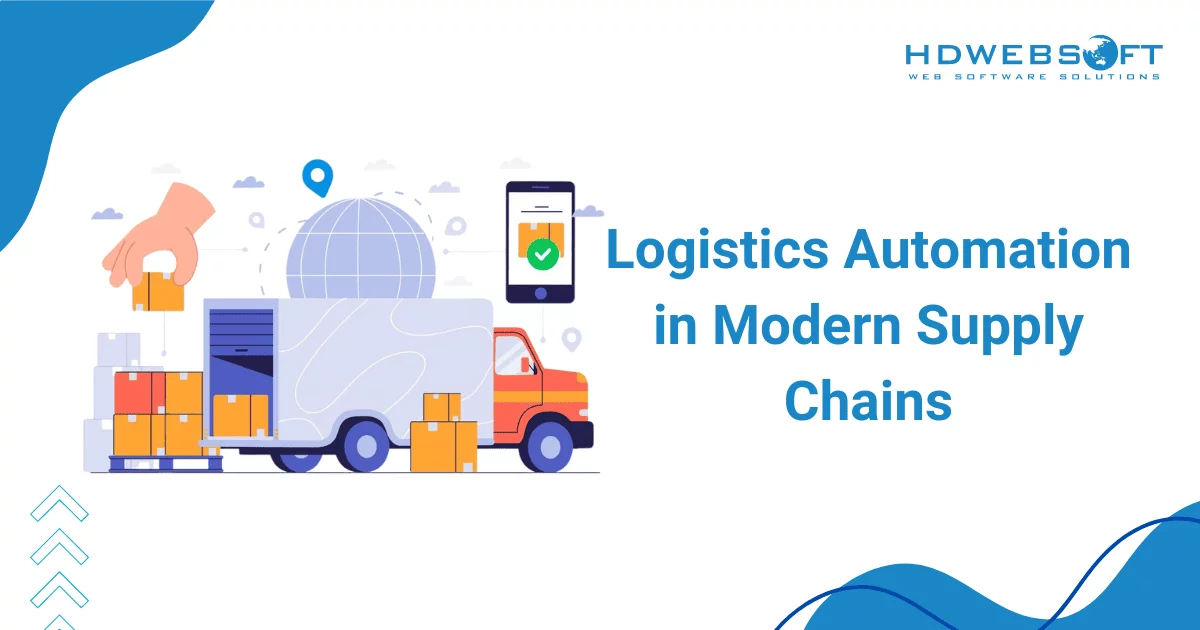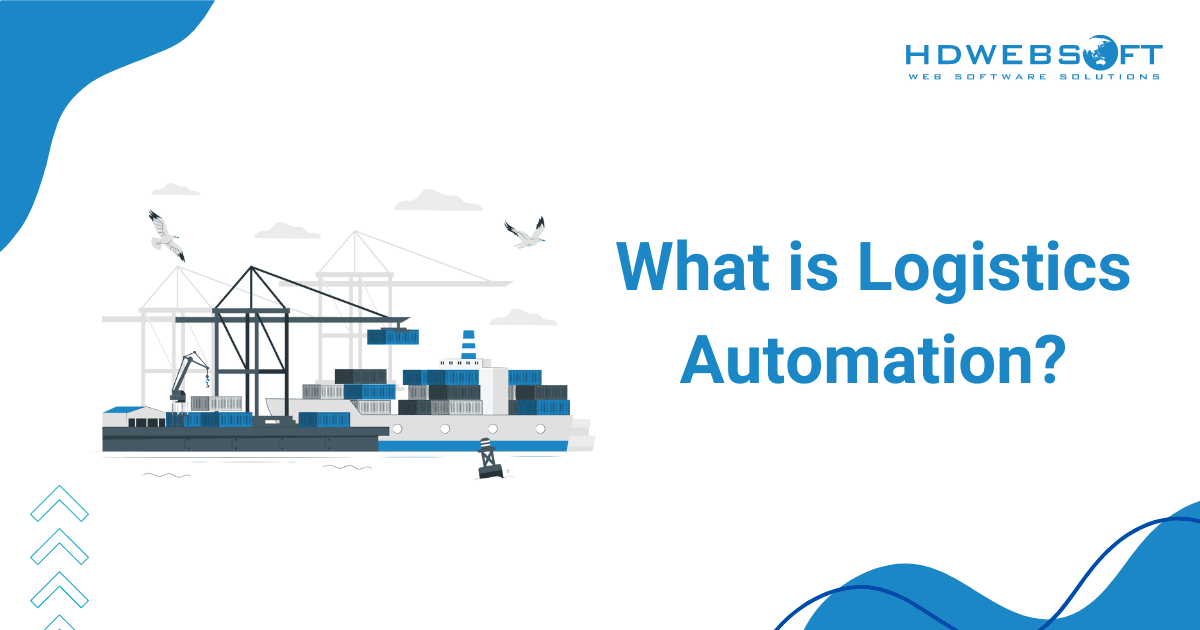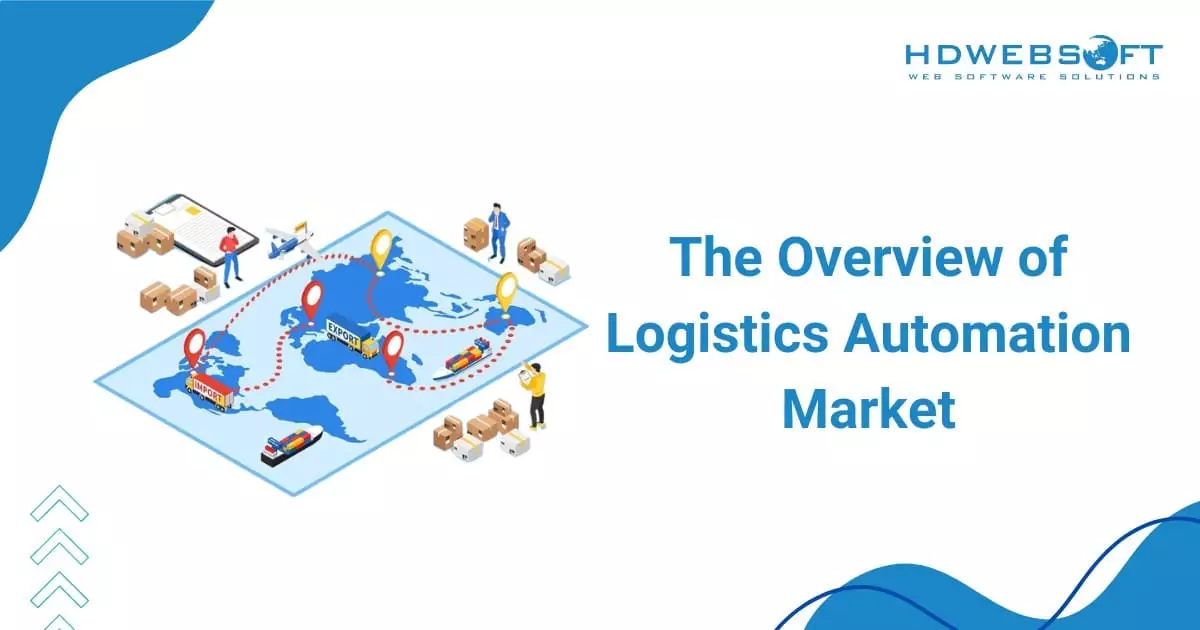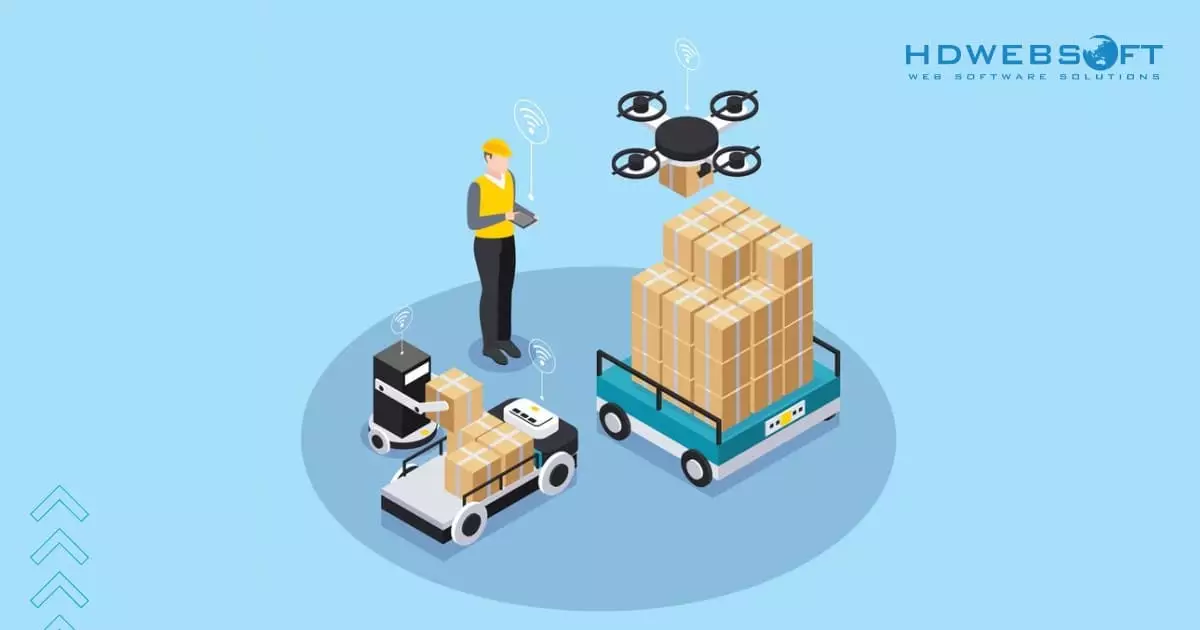
Logistics Automation in Modern Supply Chains
Logistics automation is revolutionizing the way businesses operate in an increasingly globalized and competitive world. As companies seek to improve efficiency and reduce operational costs, automation in logistics is becoming a game-changer. For instance, it leverages advanced technologies to streamline the movement of goods, making operations faster and more efficient.
In this blog, we’ll explore what logistics automation entails, the benefits it brings, current market trends, and its future outlook.
What is Logistics Automation?

Logistics automation refers to integrating technology to manage logistics operations, from inventory management to shipping and transportation. This technology replaces or reduces the need for human intervention in various processes, streamlining operations and increasing productivity.
Whether it’s automating order picking in warehouses or optimizing delivery routes, automated logistics covers a wide range of activities. It also includes tracking shipments in real-time, all aimed at making the supply chain more efficient.
Let’s take a look at some common technologies used in logistics automation:
- Automated guided vehicles (AGVs) for transporting goods inside warehouses.
- Warehouse Management Systems (WMS) and Transportation Management Systems (TMS) to oversee and optimize warehouse and delivery processes.
- Robotics for handling tasks such as packing and sorting.
- AI algorithms for predictive analytics and demand forecasting.
The Overview of Logistics Automation Market

The global logistics automation market has experienced substantial growth in recent years and is expected to continue its upward trajectory. According to a report, the market was valued at $38.76 billion and is projected to expand at a CAGR of 15.90% throughout the forecast period. This growth is driven primarily by the rapidly expanding e-commerce sector, which has led to increasing demand for quicker deliveries. Moreover, the need for more efficient supply chain operations also plays a crucial role in fueling this surge.
One of the most significant trends in the automation in logistics market is the rise of warehouse automation. As more companies adopt ASRS and robotics to increase efficiency, the warehouse automation segment is expected to dominate the market. In 2023, the market for warehouse automation alone was estimated at around $23 billion globally. This growing trend highlights the increasing reliance on automation to meet the demands of modern supply chains.
The Benefits of Logistics Automation
As supply chains grow more complex, businesses are increasingly turning to logistics automation to streamline operations and maintain competitiveness. Here, we’ll explore the benefits of automated logistics and see why it matters to business:
Improved Efficiency
One of the most significant benefits of automated logistics is the marked improvement in operational efficiency. By automating repetitive tasks, such as inventory management, order processing, and shipping, businesses can significantly cut down processing times.
For instance, robots can pick, sort, and pack goods in warehouses significantly faster than humans. What is more, automatic logistics systems ensure accurate real-time tracking of shipments. This speed enables businesses to keep up with high consumer demand, reduce delays, and operate more productively.
Furthermore, automation reduces the need for manual intervention, which minimizes human error. With automated systems handling tasks that typically take longer, employees can concentrate on more strategic work. Desirably, they enhance productivity and foster innovation, as teams can dedicate their time to creative problem-solving and improving customer experiences.
Cost Reduction
Although integrating logistics automation may involve an initial investment in technology, the long-term cost savings are undeniable. Automation reduces the reliance on labor, which directly lowers operational expenses. Automating key tasks allows businesses to reduce workforce costs while also minimizing expenses related to human error, such as lost or misdelivered goods. This dual benefit enhances operational efficiency and contributes to overall cost in logistics and supply chain management.
Additionally, optimized routes and better inventory management can save money on fuel, reduce waste, and improve resource allocation. Not only does this bring down operational costs, but also boosts profit margins, allowing companies to reinvest in growth areas.
Enhanced Accuracy and Reliability
Automated logistics enhances the accuracy and reliability of supply chain operations. Automated systems can handle tasks with precision, reducing the likelihood of human error in processes such as order fulfillment, inventory tracking, and data entry by leveraging text analysis techniques. Consequently, this accuracy is essential for businesses that need to maintain precise stock levels and consistently meet customer expectations. Furthermore, by minimizing errors, companies can improve their overall operational efficiency and customer satisfaction.
For example, WMS in logistics automation ensures that products are stored and retrieved in the right place at the right time. Meanwhile, TMS optimizes routes to avoid delays and missed deliveries. By automating these logistics processes, businesses can provide a more reliable service, which, in turn, enhances their reputation with customers.
Scalability
Another key benefit of automation in logistics is its ability to scale with business growth. As demand fluctuates, businesses can adapt without the need to proportionally increase staffing levels. Hence, automated systems can handle an increased workload without significant changes to the infrastructure, allowing companies to expand more efficiently.
To be specific, during peak shopping periods like Black Friday or the holiday season, an automated warehouse can ramp up its operations to meet increased demand. This capability is achieved without sacrificing quality or extra temporary labor, making it essential for businesses to manage high volumes. Owing to WMS, this flexibility is invaluable for companies that operate in competitive markets.

Automated logistics assist businesses in managing high-volume goods for sale season.
Data-Driven Decision Making
Logistics automation systems collect vast amounts of data, including shipping times and inventory levels. Consequently, businesses can leverage this information to make more informed decisions. This real-time logistics data analytics enables companies to continuously monitor their operations, spot inefficiencies, and accurately forecast future demand. As a desirable result, organizations can enhance operational efficiency and better align their resources with market needs.
Through AI-powered analytics, businesses can gain insights into consumer behaviors. The system allows them to optimize supply chain processes and offer better customer experiences. Data-driven decision-making is one of the most powerful aspects of logistics automation because it helps businesses respond to market changes quickly and effectively.
Enhanced Customer Satisfaction
With faster processing times, accurate deliveries, and real-time tracking, automated logistics directly contribute to improved customer satisfaction. Automated systems can make sure that orders are fulfilled more rapidly and accurately. At the same time, real-time tracking lets customers know exactly when their packages will arrive. Resultantly, this transparency and reliability improve the overall customer experience, which is crucial in today’s highly competitive market.

When everything is convenient for customers, the goal of logistics automation is achieved.
Logistics automation also helps businesses provide more consistent service, reducing the number of delays or mistakes that could lead to customer dissatisfaction. As a result, businesses that invest in logistics automation are better equipped to build lasting relationships with their customers.
Barriers to Automated Logistics
While the technology offers immense benefits to businesses, it is not without challenges. Let’s explore some of the most common barriers to automated logistics and why businesses must address them head-on.
High Initial Costs
One of the biggest hurdles companies face when transitioning to smart logistics is the high upfront investment required. Automating logistics processes often involves purchasing new technologies, such as warehouse robots, automated storage systems, or transportation management software. In addition to these physical assets, companies must invest in infrastructure upgrades, including IT systems and network integrations, to ensure seamless communication between automated solutions.
These costs can be prohibitive for SMEs, making it difficult to justify the ROI in the short term. However, it’s important to recognize that these costs are often offset by long-term savings and efficiency gains. The challenge is balancing the need for automation with the financial capabilities of the business.
Resistance to Change
Implementing logistics automation doesn’t just affect technology—it also impacts people. Employee resistance is a common barrier when introducing automation, as workers may fear it will render their jobs obsolete. This fear can lead to pushback, low morale, and reluctance to adopt new processes, which ultimately slows down the integration of automated systems.
In order to overcome this barrier, businesses need to focus on change management strategies or host workshops. Such things will help emphasize the benefits of automation for both the company and its employees.
Incredibly, rather than replacing jobs, advanced technologies in supply chains often shift employee roles to more strategic tasks. Obviously, offering training and upskilling opportunities can help workers transition into new positions, alleviating concerns and encouraging support for automation.
Integration with Legacy Systems
Many companies looking to implement automation in logistics encounter challenges when integrating new technologies with existing legacy systems. These older systems, which may have existed for years, often lack the flexibility and compatibility to work with modern tools. As a result, businesses may experience significant delays. This occurs as they either upgrade their systems or develop custom solutions to ensure interoperability between old and new technologies.

Integrating old and new systems for logistics automation can be a hazard.
Integrating logistics automation also involves synchronizing data across various systems. However, this process can become complicated if the underlying platforms do not communicate effectively with each other. Therefore, successful automation requires a unified system that ensures smooth communication and real-time data sharing. Unfortunately, establishing such a system can take time and effort, but the long-term benefits are worth it.
Complexity of Technology
While automated logistics offer numerous advantages, the complexity of implementing and maintaining these systems can pose a barrier. Many companies underestimate the level of technical expertise required to manage automated solutions.
For example, robotic systems and AI-driven software require specialized knowledge for troubleshooting, updates, and customization. Without in-house expertise or access to external support, businesses may find themselves struggling to maintain their automated systems over time.
Additionally, the complexity of configuring automated processes to suit the unique needs of the business can create further challenges. Every supply chain operates differently, and creating customized workflows for the technology often involves intricate programming, testing, and optimization.
Cybersecurity Risks
As businesses adopt logistics automation, they must also contend with increased cybersecurity risks. Automated systems rely heavily on data collection, analysis, and sharing, which makes them vulnerable to cyberattacks. A breach in logistics automation systems could lead to data theft and disrupted operations. Additionally, it may result in the loss of sensitive information, which could have severe financial and reputational repercussions for businesses.

Automated logistics handle sensitive data, which may be a target for cyberattacks.
To mitigate these risks, businesses must invest in robust cybersecurity measures like encryption, secure data protocols, and regular security audits. However, this adds another layer of complexity and cost to the automation process, creating yet another barrier to adoption.
Read more: Best Practice for Securing Node.js Application.
Lack of Skilled Workforce
A lack of skilled labor is another significant barrier to implementing automation in logistics. As businesses shift toward automated systems, the demand for workers who can operate, maintain, and optimize these technologies grows. However, finding employees with the right skill sets, such as expertise in robotics, AI, and data analysis, can be challenging.
With that in mind, businesses may need to invest in employee training or partner with external consultants to fill this knowledge gap. However, this can be time-consuming and expensive, delaying the adoption of automation and impacting overall efficiency in the short term.
The Future of AI and Automation in Logistics
The future of logistics automation looks promising, with AI playing a central role in shaping the next generation of supply chain solutions. AI-powered algorithms are already optimizing route planning, predicting demand, and enabling real-time inventory management. With AI’s predictive capabilities, companies can better forecast demand, reducing the risk of overstocking or stockouts.
In the near future, we can expect an increase in fully autonomous warehouses. In these facilities, robots will handle the entire process, including picking, packing, sorting, and loading. Autonomous vehicles and drones are also expected to revolutionize transportation, as they’ll speed up deliveries and reduce human intervention.

Drones, as a logistics automation solution, will be used to speed up the delivery process.
Moreover, blockchain technology is gaining traction in logistics automation. It enables secure and transparent tracking of goods, enhancing trust between stakeholders in the supply chain. By reducing fraud and ensuring accurate record-keeping, blockchain could further optimize the logistics industry.
Lastly, climate change is one of the most discussed and critical topics in our era. The logistics industry accounted for roughly 16% of global greenhouse gas (GHG) emissions. This is why transportation ranked as the second-largest contributor to emissions globally, making emphasizing sustainability important for the industry. Renewable energy software, when paired with automatic logistics, can assist in energy consumption in warehouses and transportation, reducing the environmental impact of logistics operations.
As AI software and automation continue to evolve, businesses will reap the benefits of more efficient, cost-effective, and responsive supply chains. Ultimately, this evolution will enhance their competitiveness in the market.
Conclusion
Logistics automation is no longer a distant future; it is here and transforming how businesses handle their supply chain operations. By leveraging advanced technologies, companies can increase efficiency, reduce errors, and better meet the demands of an increasingly fast-paced world. While there are barriers to full-scale adoption, the benefits far outweigh these challenges.
Moreover, automated logistics helps reduce operational costs while improving safety and enhancing data insights. In short, this transformation drives the industry toward a more efficient and innovative future.
As the logistics market grows, businesses embracing automation will gain a competitive edge and prepare for future supply chain management.









